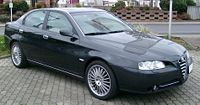Alfa Romeo 166
| Alfa Romeo | |
|---|---|
|
Alfa Romeo 166 (1998-2000)
|
|
| 166 | |
| Production period: | 1998-2007 |
| Class : | upper middle class |
| Body versions : | limousine |
| Engines: |
Otto engines : 2.0–3.2 liters (110–177 kW) Diesel engines : 2.4 liters (100–136 kW) |
| Length: | 4720 mm |
| Width: | 1800 mm |
| Height: | 1416 mm |
| Wheelbase : | 2700 mm |
| Empty weight : | 1415-1655 kg |
| Previous model | Alfa Romeo 164 |
The Alfa Romeo 166 is a sedan from the Italian car brand Alfa Romeo . It was introduced in October 1998 as the successor to the Alfa Romeo 164 .
Model history
Technically, a distinction can be made between three series: the first until autumn 2000, the second until late summer 2003 and the third until the end of production in mid-2007.
idea
The vehicle was first shown to the press in Madrid in September 1998, and it went on sale in Italy the following month. It was shown in public for the first time at the Mondial de l'Automobile of the same year.
Facelift
In October 2000, the engines were initially revised because the legislature passed the new Euro 3 emissions standard , which the previous engines with the Euro 2 standard could not meet. At the same time, the gasoline engines were designed for the so-called OBD 2 or E-OBD standard. There was also a new, more powerful navigation system called "G3".
In September 2003, with the second facelift , which was formally presented at the IAA , the front section was changed, which now bore the family face as on the 156, 147, GTV and GT models.
End of production
In June 2007, the production of the large sedan was stopped. She received no successor.
In December 2010. China imported GAC Trumpchi GA 5 builds on the platform of the 166th Guangzhou Auto acquired the rights in 2009.
design
For cost reasons, the body is very similar to that of its predecessor, for example the position and shape of the front and rear windows.
In the first two versions, the relatively small headlights (halogen or optionally xenon light ) with the dipped beam on the inside, which was rare at the time, and the high beam headlamps with integrated parking lights on the outside, were striking. The flat “nose” of the vehicle was also unusual.
In the third version, the front was redesigned, which was now more rounded. It had wider headlights (optionally with bi-xenon light) and a "Scudetto" (Alfa heart) twice as large as well as a front license plate offset to the left. Only the materials changed in the interior.
The vehicle also contained a small technical innovation, because when it went on sale in autumn 1998, Alfa Romeo replaced the light-emitting diodes that were still common at the time in the turn signals of the rear taillights . It was not until eight to ten years later that this technology was widely installed by many other manufacturers and sold as a major innovation in the media. Alfa Romeo did not advertise it at the time, and so the first use of LEDs for exterior lighting remained practically unknown.
Body and chassis
The 166 is based on the floor pan of the previous model, which, however, has been revised with new wheel suspensions. There is a double wishbone construction on the front axle instead of MacPherson struts and instead of the Camuffo rear axle of the predecessor, a multilink axle on a cast aluminum beam.
drive
Engines
After the market launch, the vehicle was initially available with a 2.0-l R4 petrol engine , a 2.0-l V6 petrol engine with turbocharging , a 3.0-l V6 petrol engine and a 2.4-l petrol engine . R5 diesel engine with turbocharging and common rail injection can be bought.
New from the second facelift in 2003 was the 2.4-liter R5 diesel engine with turbocharging (JTD) with 20 valves and a maximum output of 129 kW (later 132 kW), which was available with a six-speed manual gearbox or a new five-speed Automatic transmission available (but then with reduced maximum torque, 330 Nm instead of 400 Nm).
Over the years, one engine after the other was taken out of the range; from summer 2006 only the 3.2-l petrol engine and the 2.4-l diesel engine (132 kW) were available.
transmission
In the first two series, the 2.5 and 3.0 l engines had either a 5-speed (later 6-speed) manual transmission or a 4-speed automatic transmission (Sportronic) from ZF . The automatic transmission could also be switched manually.
From the second facelift in 2003, the automatic transmission was only available for the 3.0-l engine, the 3.2-l engine (known from the 156 GTA, but 7 kW less here) only with a 6-speed manual gearbox.
Technical specifications
| model | Motor type | Engine type | Displacement | Max. power | Construction period |
|---|---|---|---|---|---|
| 2.0 Twin Spark | Gasoline engine | R4 | 1970 cc | 110 kW (150 PS) | 10 / 2000-07 / 2006 |
| 2.0 Twin Spark | 1970 cc | 114 kW (155 PS) | 09 / 1998-09 / 2000 | ||
| 2.0 V6 T B (1) | 6th | 1996 cc | 151 kW (205 PS) | 09 / 1998-10 / 2000 | |
| 2.5 V6 24V | 2492 cc | 138 kW (188 hp) | 10 / 2000-09 / 2003 | ||
| 2.5 V6 24V | 2492 cc | 140 kW (190 hp) | 09 / 1998-09 / 2000 | ||
| 3.0 V6 24V | 2959 cc | 162 kW (220 PS) | 10 / 2000-07 / 2006 | ||
| 3.0 V6 24V | 166 kW (226 hp) | 09 / 1998-09 / 2000 | |||
| 3.2 V6 24V | 3179 cc | 177 kW (240 PS) | 09 / 2003-06 / 2007 | ||
| 2.4 JTD 10V | Diesel engine | R5 | 2387 cc | 100 kW (136 hp) | 09 / 1998-09 / 2000 |
| 2.4 JTD 10V | 103 kW (140 PS) | 10 / 2000-04 / 2002 | |||
| 2.4 JTD 10V | 110 kW (150 PS) | 04 / 2002-06 / 2005 | |||
| 2.4 JTD 20V | 129 kW (175 hp) | 09/2003-07/2006 | |||
| 2.4 JTD 20V M-Jet | 132 kW (180 PS) | 07/2005-06/2007 | |||
| 2.4 JTD 20V M-Jet (2) | 136 kW (185 hp) | 07 / 2006-06 / 2007 |
distribution
The Alfa 166 did not prove to be a commercial success, at least in Germany. After initially quite good numbers (3572 registered cars in the first full year) the registrations of the big Alfa have since declined significantly. In 2006 they fell to 116 approvals.
A total of 96,575 copies of the 166 were produced in nine years, of which 10,222 units were exported to Germany. Of the predecessor, the Alfa Romeo 164, 273,000 copies had been made in ten years.
With the Alfa Romeo 159 , a significantly larger successor to the 156 was released in September 2005 , which came very close to the 166 in terms of interior and exterior dimensions, even exceeded it in width and featured a number of modernized design elements, including in the interior.
Individual evidence
- ^ Claudio Nobis: E con la 166 l 'Alfa Romeo va alla conquista d' Europa - la Repubblica.it. In: ricerca.repubblica.it. September 18, 1998, accessed February 11, 2019 (Italian).
- ↑ Luca Ciferri: ALFA TO GROW OVERSEAS WITH 166. In: europe.autonews.com. September 28, 1998, accessed February 11, 2019 .
- ↑ a b ALFA ROMEO AT THE 73rd PARIS INTERNATIONAL MOTOR SHOW - Press Releases - Fiat Chrysler Automobiles EMEA Press. In: alfaromeopress.com. September 28, 1998, accessed February 11, 2019 .
- ^ Alfa Romeo: Fine nose - manager magazin. In: manager-magazin.de. September 5, 2003, accessed February 11, 2019 .
- ↑ mme / dpa: The Alfa Romeo 166 used: Big is not always good - n-tv.de. In: n-tv.de. December 4, 2009, accessed February 11, 2019 .
- ^ Guangzhou Auto Show: Guangzhou Auto Trumpchi Listed & Priced. December 20, 2010, accessed January 13, 2019 .
- ↑ ALFA 166: FURTHER INFORMATION - Press Releases - Fiat Chrysler Automobiles EMEA Press. In: alfaromeopress.com. September 17, 1998, accessed February 11, 2019 .
- ↑ ALFA 166: SUSPENSION - Press Releases - Fiat Chrysler Automobiles EMEA Press. In: alfaromeopress.com. September 17, 1998, accessed February 11, 2019 .
- ↑ ALFA 166: GEARBOXES - Press Releases - Fiat Chrysler Automobiles EMEA Press. In: alfaromeopress.com. September 17, 1998, accessed February 11, 2019 .
- ↑ New registrations - reporting month: December 2006. New registrations of passenger cars by brand and model series. (PDF) In: files.vogel.de. Kraftfahrt-Bundesamt, p. 1 , accessed on February 10, 2019 .
Web links
| Timeline of Alfa Romeo models from 1945 to today | ||||||||||||||||||||||||||||||||||||||||||||||||||||||||||||||||||||||||||||
|---|---|---|---|---|---|---|---|---|---|---|---|---|---|---|---|---|---|---|---|---|---|---|---|---|---|---|---|---|---|---|---|---|---|---|---|---|---|---|---|---|---|---|---|---|---|---|---|---|---|---|---|---|---|---|---|---|---|---|---|---|---|---|---|---|---|---|---|---|---|---|---|---|---|---|---|---|
| Type | Independent until 1933, then state-owned | from 1986 part of Fiat | ||||||||||||||||||||||||||||||||||||||||||||||||||||||||||||||||||||||||||
| 1940s | 1950s | 1960s | 1970s | 1980s | 1990s | 2000s | 2010s | 2020s | ||||||||||||||||||||||||||||||||||||||||||||||||||||||||||||||||||||
| 5 | 6th | 7th | 8th | 9 | 0 | 1 | 2 | 3 | 4th | 5 | 6th | 7th | 8th | 9 | 0 | 1 | 2 | 3 | 4th | 5 | 6th | 7th | 8th | 9 | 0 | 1 | 2 | 3 | 4th | 5 | 6th | 7th | 8th | 9 | 0 | 1 | 2 | 3 | 4th | 5 | 6th | 7th | 8th | 9 | 0 | 1 | 2 | 3 | 4th | 5 | 6th | 7th | 8th | 9 | 0 | 1 | 2 | 3 | 4th | 5 | 6th | 7th | 8th | 9 | 0 | 1 | 2 | 3 | 4th | 5 | 6th | 7th | 8th | 9 | 0 | |
| Small car | MiTo (955) | |||||||||||||||||||||||||||||||||||||||||||||||||||||||||||||||||||||||||||
| Compact class | Arna | |||||||||||||||||||||||||||||||||||||||||||||||||||||||||||||||||||||||||||
| Alfasud | 33 | 145 , 146 (930) | 147 (937) | Giulietta (940) | ||||||||||||||||||||||||||||||||||||||||||||||||||||||||||||||||||||||||
| Middle class | Giulietta Berlina | Giulia | Giulietta (type 116) | 75 | 155 | 156 (932) | 159 (939) | Giulia (952) | ||||||||||||||||||||||||||||||||||||||||||||||||||||||||||||||||||||
| upper middle class | Alfetta | 90 | 164 | 166 (936) | ||||||||||||||||||||||||||||||||||||||||||||||||||||||||||||||||||||||||
| ... | 6C 2500 | 1900 Berlina | 2000 Berlina | 2600 Berlina | 1750/2000 Berlina | Alfa 6 | ||||||||||||||||||||||||||||||||||||||||||||||||||||||||||||||||||||||
| Coupe | Giulietta Sprint | Giulia Sprint GT | Alfasud Sprint | GT (937) | ||||||||||||||||||||||||||||||||||||||||||||||||||||||||||||||||||||||||
| 1900C sprint / super sprint | 2000 sprint | 2600 sprint | 1750/2000 GT Veloce | Alfetta GT / GTV | GTV (916) | Brera (939) | ||||||||||||||||||||||||||||||||||||||||||||||||||||||||||||||||||||||
| Cabriolet | Giulietta Spider | Giulia Spider | Spider ("Duetto") | Spider (916) | Spider (939) | |||||||||||||||||||||||||||||||||||||||||||||||||||||||||||||||||||||||
| 2000 spider | 2600 spider | |||||||||||||||||||||||||||||||||||||||||||||||||||||||||||||||||||||||||||
| Sports car | Disco Volante | Tipo 33 | Montreal | SZ / RZ | 8C Competizione | 4C | ||||||||||||||||||||||||||||||||||||||||||||||||||||||||||||||||||||||
| Off-road vehicle and SUV | Matta | Stelvio (949) | ||||||||||||||||||||||||||||||||||||||||||||||||||||||||||||||||||||||||||
| Vans | Romeo | F12 / A12 | AR6 | |||||||||||||||||||||||||||||||||||||||||||||||||||||||||||||||||||||||||
| AR8 | ||||||||||||||||||||||||||||||||||||||||||||||||||||||||||||||||||||||||||||
|
|
||||||||||||||||||||||||||||||||||||||||||||||||||||||||||||||||||||||||||||





